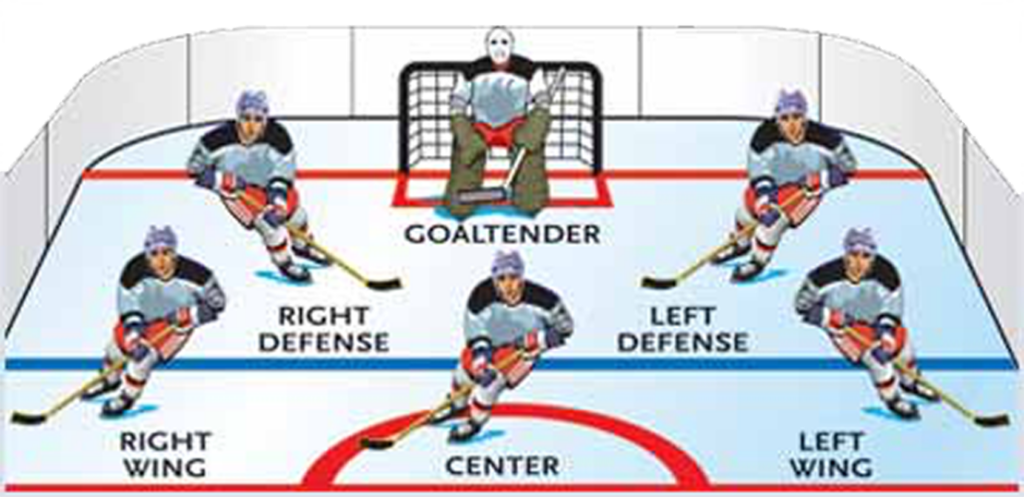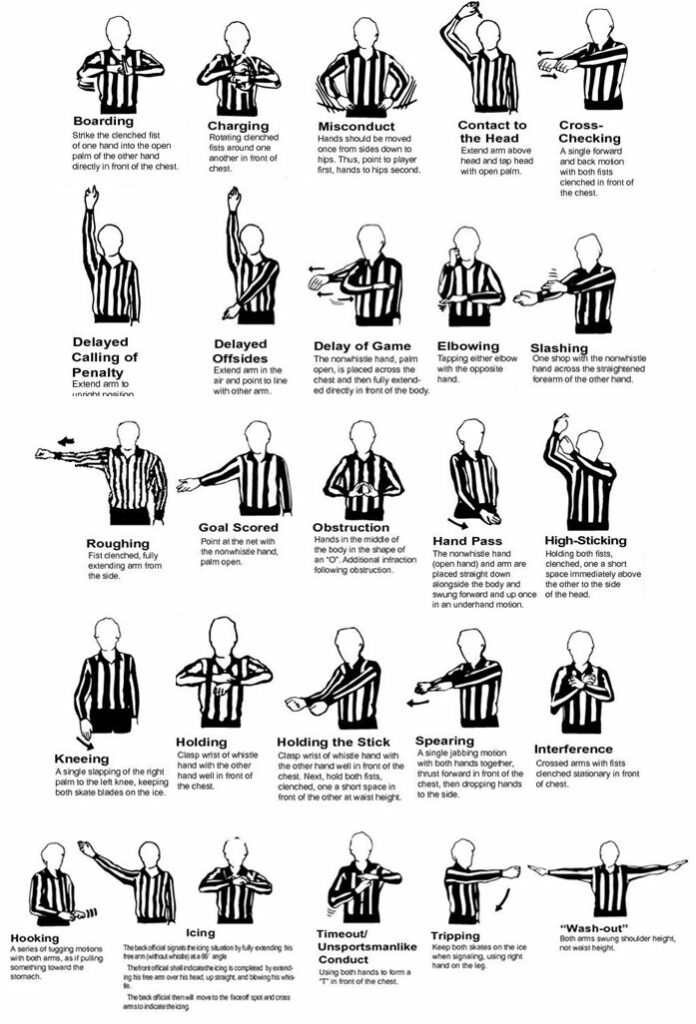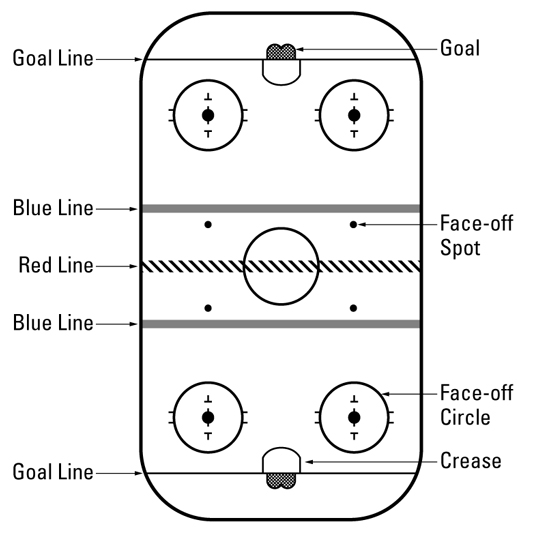THE POSITIONS

GOALTENDER: Also known as the “goalie.” His primary responsibility is to keep the puck out of the net. Occasionally, he will get credit for an assist, and only rarely scores a goal (usually by shooting the puck into the opposing net after the other team has pulled its goalie). He cannot touch the puck on the other side of the red line.
FORWARDS: The two wings and the center. The three players often make up a “line” and play together. The two wings’ primary area is on the outside of the rink, and must be physical and willing to dig the puck off the boards. The center typically plays in the middle and is the “quarterback” of the team. Centers are expected to cover more area than any other player, and are often the most creative skaters on the ice. The center is most often responsible for taking faceoffs, but other players sometimes are asked to take faceoffs as well.
DEFENSEMEN: A left defenseman and a right defenseman make up a “pairing.” Their primary responsibilities are to help the goalie keep the puck out of the net, and start the offense once their team takes control of the puck. Some are “stay-at-home” defensemen who specialize in their defensive role, while others are “two-way” defensemen who are more skilled at the offensive end of the rink.
|
THE REFEREE SIGNALS

REFEREE: Wears the orange armbands, and is in charge of the officiating crew for any game. The referee is the only official with the authority to issue penalties.
LINESMEN: Are primarily responsible for watching violations regarding the red and blue lines (such as offside and icing). Linesmen are also expected to break up altercations during the game.
|
ABOUT THE GAME

The goal is simple: score more times than your opponent, and you win. A regulation hockey game is 60 minutes long, split into three periods of 20 minutes each. If the game is tied after 60 minutes, a five-minute sudden-death overtime is played, followed by a three-round shootout. (If the shootout is tied after three rounds, extra rounds are played until one team has scored more than the other. In the playoffs, teams continue to play 20 minutes at a time until one team scores.)
The ice surface is called a “rink” – other sports use a ball, but hockey uses a vulcanized rubber “puck,” which the players shoot and pass with their sticks. The dasher “boards” are topped by Plexiglas that surround the ice, separating the crowd from the rink and helping to keep the puck in play. When play stops, it is restarted with a faceoff, at one of the nine dots on the ice meant for that purpose.
Most of the time, each team has six players on the ice, including the goalie – no team is ever allowed to play with fewer than four. Teams can – and frequently do – substitute while the puck is in play. A team may be forced to play short a player for two minutes if a penalty is called – more dangerous and flagrant penalties may last for four or five minutes. A team can be forced to play without a particular player for 10 minutes – or for the rest of a game – for a misconduct penalty, but does not have to play short a player during that time.
|
Q & A
HOW BIG IS THE GOAL? Six feet wide, and four feet high.
WHO GETS CREDIT FOR AN ASSIST? Assists are awarded to up to the last two players on the scoring team who touch the puck before the player who scores. If a player scores into his own net, the last player on the other team to touch the puck gets credit for the goal.
IS IT A GOAL IF THE PUCK STOPS ON THE GOAL LINE? No. The puck must completely cross the goal line.
CAN THE PUCK BE KICKED OR THROWN INTO THE NET? No. A deflection off of any part of the body is fine, though – in fact, players often practice deflecting the puck in another direction in order to score or move the puck in a desired direction.
ARE ALL STICKS ALIKE? No. Hockey sticks are highly customized, like baseball bats – each player has his preference in terms of size, the angle of the blade, etc.
HOW ABOUT THE ICE? Hockey ice is typically maintained at 16 degrees, and about 3/4″ thick. Miles of small pipes underneath the rink help to keep the rink frozen. Only part of the ice is built up before the rink is painted white, and before the lines and logos are painted or laid down onto the ice. The rest of the ice on top keeps the lines and logos sealed underneath the surface of the rink.
AND THE PUCK? The puck is one inch thick and three inches across, weighing roughly six ounces. It is kept frozen before being put into play in order to minimize bouncing.
WHAT IS A “HAT TRICK?” A hat trick is another way of saying that a player has scored three goals in a single game. The term goes back to the 1850s, and originally applied to a different sport: cricket. Legend has it, a bowler (similar to a pitcher), took three wickets on three straight balls. This was such an incredible trick, the fans took up a collection and rewarded him with a hat.
WHY DO THE LINESMEN HAVE TO BREAK UP FIGHTS? Since the referee is responsible for handing out penalties during a game, the referee is observing which players should receive penalties, and has to focus on restoring order and staying in control of the game.
HOW FAST DOES THE PUCK TRAVEL? Shots from junior players don’t travel quite as fast, but shots from pro hockey players have been clocked at well over 100 miles per hour. The puck has been known to curve in flight like a baseball, making the goalie’s job even harder. Nets are required to be above the glass at each end of the rink to protect fans sitting behind the goals from these shots.
|
RULES, EQUIPMENT, ETC.
“A” – Letter worn on the alternate captains’ jerseys. See “C” below.
ATTACKING ZONE – The opposing team’s end of the ice, beyond the blue line.
BIRDCAGE – The full-face wire cage that many players have attached to their helmets while on the ice. See “fishbowl” below.
BISCUIT – Another name for the puck. “Putting the biscuit in the basket” is slang for scoring a goal.
BLOCKER – The rectangular pad that the goalie wears opposite his glove hand. See “waffle” below.
BREAKAWAY – When a player skates with the puck toward the other team’s goalie, with no defenders in between.
BREEZERS – Hockey pants.
BUCKET – A player’s helmet.
“C” – Letter worn on the captains’ jerseys. See “A” above.
CAGE – Another name for the goal.
CROSSBAR – The bar that connects the two posts on the net. The crossbar is exactly four feet off the ice.
DEFENSIVE ZONE – A team’s own end of the rink, behind its own blue line.
EMPTY-NET GOAL – A goal that is scored while the opposing goalie is not on the ice.
EVEN STRENGTH – When both teams have the same number of players on the ice. When both teams have six players on the ice (including the goalie) this is “full strength.”
EXTRA ATTACKER – The skater that replaces a team’s goalie on the ice, usually when trailing at the end of a close game.
FACEOFF – The method used to restart play after a stoppage, where an official drops the puck between a player from each team.
FISHBOWL – The full-face plastic shield that many players have attached to their helmets while on the ice. See “birdcage” above.
GOAL JUDGE – An off-ice official who helps the referees and linesmen determine when the puck has entered the net. The goal judge turns on a red light to signal that a goal has been scored.
HAND PASS – The act of passing the puck with one’s hand. Legal only behind a team’s own blue line.
ICING – When a player shoots the puck from his own half of the rink across the other team’s goal line without scoring a goal or the puck being touched. (Does not apply during a penalty kill)
LINE CHANGE – When teams substitute multiple players at one time. Usually, a forward line (three players) or a defensive pairing (two players), or both, are substituted together.
MAN-ADVANTAGE – Another name for the power play. A team that is playing 5-on-3 is said to have a “two-man advantage.”
NEUTRAL ZONE – The space at the middle of the rink, between the blue lines.
OFFICIALS’ CREASE – The semi-circle in front of the scorer’s bench where officials can discuss among themselves, or with the off-ice officials. The radius of this semi-circle is 10 feet – no players are permitted inside it while the officials are in discussion.
OFFSIDE – Is called when a player enters the attacking zone before the puck.
PENALTY BOX – Where penalized players sit while required to remain off the ice. Also known as the “sin bin.”
PENALTY KILL – The act of playing shorthanded due to at least one penalty.
PENALTY SHOT – Is awarded to a team to make up for a violation that prevents an obvious scoring chance, usually by tripping a player from behind while on a breakaway.
“THE POINT” – The area just inside a team’s blue line, next to the boards.
POWER PLAY – The act of playing with more players on the ice than an opponent due to an opponent’s penalty.
PULL THE GOALIE – When a team removes its goaltender from the ice and replaces him with an extra skater, usually when trailing late in a close game.
SIN BIN – Another name for the penalty box.
SLOT – The area directly in front of the net and between the faceoff circles.
SWEATER – Another name for a hockey jersey.
VISOR – The horizontal piece of plastic attached to the front of a player’s helmet for eye protection. Only players age 18 and older are allowed to wear one.
WAFFLE – Another name for a goalie’s blocker pad. Refers to the waffle-like appearance of older blocker pads. Also called a “waffle-board.”
ZAMBONI – Slang, and a brand name, for the ice resurfacing vehicle.
|
HOCKEY SLANG
APPLE – Another word for “assist.”
BACKHAND – A shot or pass made with the back of the blade of a player’s stick.
BARN – Another term for a hockey arena, particularly an older one with fewer creature comforts.
BAR DOWN – Describes a shot that hits the bottom of the crossbar before going into the net. Also “bar south.”
BLOW A TIRE – Refers to a hockey player losing his footing and falling to the ice.
BODY CHECK – Contact made with a hip or shoulder against an opponent.
CHERRY PICKER – A player who stands behind the opposing team’s defense in hopes of starting a breakaway.
CHICLETS – Slang for a hockey player’s teeth.
DEKE – When a player handles the puck or himself in a way that he fools the opponent. Short for “decoy.”
EMPTY NET – Describes a goal scored against a team that does not have its goalie in the net.
FACE-WASH: The act of shoving the open palm of a glove into an opponent’s face.
FIVE-HOLE – Describes a goal scored between a goaltender’s legs.
FLOW – A hockey player’s long hair. Also known as “lettuce.”
GARBAGE GOAL – A goal that is scored on the rebound. Players who score these are said to be “picking up the garbage.”
GORDIE HOWE HAT TRICK – When a player has a goal, an assist and a fight in the same game.
GRINDER – A player known more for his hard work and checking skills than for his scoring ability. Can often be found setting his teammates up for scoring chances.
HOWITZER – A very fast slap shot. Also called a “cannon.”
LIGHT THE LAMP – Another term for scoring a goal. Refers to the act of turning on the red light behind each net that signals a goal.
NATURAL HAT TRICK – When a player scores three goals in a row in a single game.
NETMINDER – Slang for the goaltender.
ODD-MAN RUSH – When a team enters another team’s zone and outnumbers the opposing players.
ONE-TIMER – The act of shooting a puck directly off of a pass, without stopping it or playing it in any way.
PLUS/MINUS – Measures how many times a player is on the ice while his team scores, and how often that player is on the ice when the opponent scores. Does not apply to either side during a power play goal.
POKE CHECK – The act of using a stick to “poke” the puck away from an opponent.
REBOUND – When the puck ricochets off of a goaltender, a defender, or the end boards following a shot.
SAUCER PASS – A pass that makes the puck spin in mid-air, similar to a flying saucer or a frisbee.
SHOT ON GOAL – Describes a shot that will enter the goal if not stopped by the goaltender. Shots on goal result in either a save, or a goal.
SHUTOUT – When a goaltender allows no goals in an entire game.
SLAP SHOT – A shot where the player winds up before shooting the puck.
SNIPER – A player with a powerful, accurate shot.
STACKING THE PADS – A save in which the goalie lays on his side and makes a save with his leg pads stacked on top of each other.
TOP SHELF – The upper area of the goal, usually between the crossbar and a goaltender’s shoulders.
WRAPAROUND – When a player controls the puck behind his opponent’s net, and tries to score by reaching around one of the posts.
WRIST SHOT – A shot that is made by snapping the wrists into the shot, rather than using a large windup to gain speed like a slap shot.
ZEBRA – Slang for a referee or linesman.
|